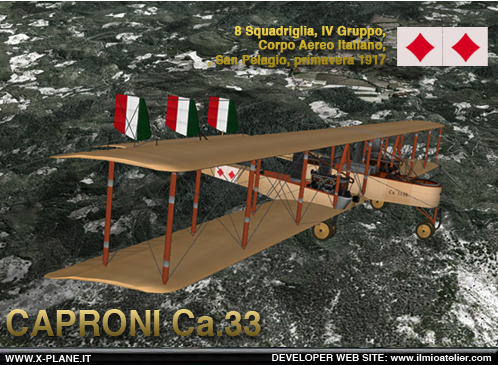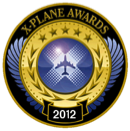

The aircraft

L’aereo
La scheda tecnica / Data
Caproni Ca.33 MM 1158 flown by 8 Squadriglia, IV Gruppo, Corpo Aereo Italiano, based at San Pelagio in the spring of 1917. The Ca.33 was one of the first strategic bombers in the world and during WW1 these planes had a very important role in the last year of war. One of these aircraft is preserved at the Vigna di Valle Museum of the Aeronautica Militare italiana. IMPORTANT: the cockpit instruments of the Ca.33 was very poor, there were only the rpm and the fuel pressure gauges; for XPlane use I've added the compass, the airspeed and the altimeter. For a better view of the cockpit, please set the FOV ad 55°.This aircraft was designed and tested using X-Plane 9.70. Thanks to Bertrand Augras for his animated pilot figure. ACF file, 3d cockpit, 3d objs, textures and panel: © 2011 Paolo Matricardi; sounds: © 2011 Chris Wraight (Dataroots).
Primo volo / First flight: 1917
Costruttore / Manufacturer: Società di Aviazione ing. Caproni
Tipo / Type: bombardiere / bomber
Motore / Engine: 3x Isotta-Fraschini V-4B, a 6 cilindri in linea raffreddati a liquido
Potenza / Power: 150 hp
Apertura alare / Wingspan: m 22,74
Lunghezza / Length: m 11,05
Altezza / Heigth: m 3,84
Superficie alare / WIngarea: mq 95,64
Peso al decollo / Takeoff weight: kg 3890
Peso a vuoto / Empty weight: 2300
Velocità max / Max speed: 140 km/h
a /at: livello del mare/ sea level
Quota max / Max ceiling: m 4800
Autonomia / Range: 4 ore / 4 hours
Armamento / Armament: 2 mg; 450 kg.
Caproni Ca.33 MM 1158 appartenente alla 8 Squadriglia, IV Gruppo, Corpo Aereo Italiano, basata a San Pelagio nella primavera del 1917. Il Ca.33 è stato il primo bombardiere strategico italiano e uno dei primi al mondo, appartenente a una famiglia di aerei il cui sviluppo sarebbe andato avanti fino agli anni Venti avanzati. Nel primo conflitto mondiale questi grandi biplani ebbero un ruolo molto importante durante l'ultimo anno di guerra. Un esemplare di Ca.33 è conservato al Museo dell'Aeronautica Militare italiana di Vigna di Valle.
IMPORTANTE: la strumentazione del Ca.33 era molto spartana,il cockpit aveva solo i contagiri e i manometri del carburante; per l'uso in X-Plane ho aggiunto la bussola, l'anemometro e l'altimetro.
Questo aereo è stato costruito e testato con X-Plane 9.70.
Per una vista ottimale del cockpit settare il FOV a 55°.
ACF file, 3d cockpit, 3d objs, textures e pannello © 2011 Paolo Matricardi; suoni: © 2011 Chris Wraight (Dataroots); Grazie a Bertrand Augras per il suo pilota animato .
